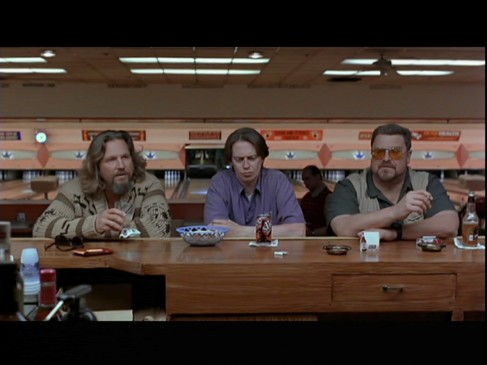The scene opens on a set of white bowling pins in a typical American bowling alley. A beer is placed in a holder. A ball rolls back into the holding bay. It is picked up and bowled. Strike. Ash is tapped from a cigarette. A ball is picked up. Sequence of various different sized Americans bowling. Man sprays shoes. Donny bowls a strike.
“I’m throwing rocks tonight .”
And so The Big Lebowski begins. Alone, this scene would be uninteresting. Despite the Coen Brothers fantastic cinematography, most notably in the way the camera follows the ball as it rolls down the lane, alone this scene would frankly be dull. So why is it such a perfect opening for such a perfect film?
Bob Dylan. I’m not going to sing praises of Bob Dylan, however much I would like to, because in fact, the song used over the Coen’s bowling montage alone, is pretty average. But in the context of this montage, it makes perfect sense. The Coen brothers indeed have perfectly married film and music at the beginning of this film. It gives a ironic twist on bowlers who are presented as being unremarkable, typical Americans, with music proclaiming there is something greater going on inside them, indeed the song is titled “The Man in Me”. It sets us up perfectly for the introduction to The Dude. Who is very much your typical American, though at least he’s housebroken. This irony about average people being great, really, is repeated again and again throughout the film. Whether it’s the paedophile Jesus, the Vietnam Veteran Walter, or the Dude himself, there is a constant suggestion that what goes on in their lives is somehow reaching towards something greater. But this all falls apart at the end, when they realise it was all one big fuck up.
The song “The Man in Me” is essentially used as a motif. Good filmmakers, such as the Coen brothers, understand the power music can hold over a film. In Casablanca the repetition of the song “As Time Goes By” holds such emotional power over the characters that whenever we even get a snippet of the song, we know instantly what the characters are feeling.
Music in films however, can be used awfully. There must be a certain subtlety to the way the music is used or it comes across as being a cheap way of covering up a montage. For music to be used in a montage, like in the Big Lebowski, to good affect the scene itself must almost be passive. Take a moment to consider the way The Libertines “Time for Heroes” is used in American Pie: The Wedding. The song is, undeniably, fucking brilliant. And while to a certain extent it is about teens going nuts and smashing shit up, it does not match up with nerdy, uninteresting teens getting drunk and trying to get laid. The combination of the two serves neither the song nor the film well.
But music in this fils is not used as a motif. Instead it attempts to match a moment within the film with music that fits suitably, that’s not to say, that this cannot be done well.
Tarantino and Scorsese are renowned for their ability to do this and unquestionably are masters of their art. Take the scene in Pulp Fiction when Vincent arrives at Marcellus’s house and Son of A Preacher Man is Playing, the irony in the song plays perfectly off the characters. Music should not be used as a cover up for a scene but should serve both the scene and the song, as Tarantino does here and as is done with Hallelujah in Watchmen. Whereas usually the song is taken to be a painfully ironic hymn to unrequited love, in this scene in Watchmen a whole new dimension is brought to the song. Love, both physically and mentally (there’s nudity kids) is presented as an escape from life, it is something sacred and something that cannot last. Hallelujah is a cry out of love in a world void of hope.
I couldn’t find the actual scene. I presume due to its sexual nature.
Music married with film can bring a new dimension to the scene and the song, but it is a delicate art and must be approached carefully. Finally I will leave you with another master of this technique. Here he uses music to create a feel to the film, and the mood of a city. That man is of course Woody Allen. Until next time.
The Dedicated Apeman x
